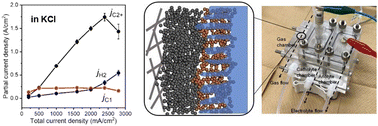Ultra-high-rate CO2 reduction reactions to multicarbon products with a current density of 1.7 A cm−2 in neutral electrolytes†
Abstract
CO2 electrolysis to value-added products is a promising technology to close the carbon cycle and sequester anthropogenic CO2 into chemical feedstocks; an increase of the current density for multicarbon products is one of the requirements for practical implementation. We have successfully increased the partial current density for gaseous CO2 reduction reactions to multicarbon products (C2+) over Cu nanoparticles on gas diffusion electrodes in neutral electrolytes to a record value of 1.7 A cm−2. The faradaic efficiency for multicarbon products increased with the current density below total current density of 2000 mA cm−2 and reached 76% at a total current density of 1600 mA cm−2. The turnover frequency for the production of C2+ per Cu atoms exceeded 1.1 s−1. Optimizing the standard components and their assembly as the cathode elicits the high-turnover frequency of oxide-derived Cu catalysts, resulting in the record partial current density for C2+. Especially, we demonstrated that the thickness of catalyst layers was one highly sensitive factor in determining the maximum current density for C2+.

- This article is part of the themed collections: EES Family journals: showcase collection and Carbon Dioxide utilisation


 Please wait while we load your content...
Please wait while we load your content...